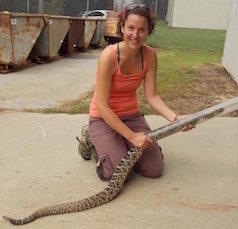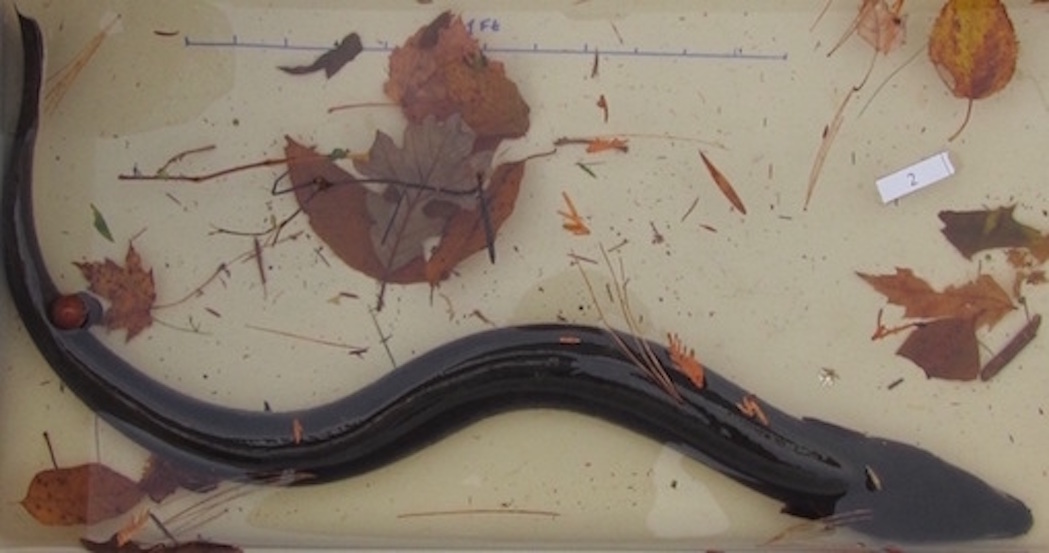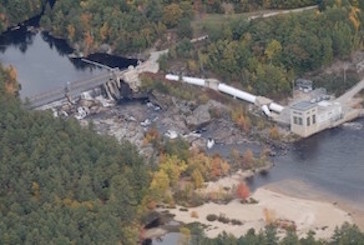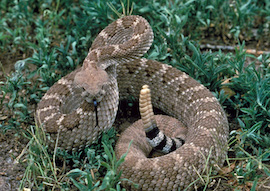Snakebit
Ph.D. student Berlynna Heres cut her research teeth on eastern diamondback rattlesnakes but arrived at UMaine to find out how American eels get along with dams
By David Sims
Long before going to graduate school at Marshall University in Huntington, West Virginia, Berlynna Heres was drawn to the field of herpetology—from the Greek word “herpian” meaning “to creep.”
Snakes are among those creepy crawlies and are the ones that most captured Heres’ fancy. So to earn her master’s degree she ended up tracking, capturing, and surgically implanting radio devices in eastern diamondback rattlesnakes—the largest venomous snake in North America and reaching lengths of eight feet and weighing up to 10 pounds.

With her master’s in hand, she was poised to do similar work tracking and tagging timber rattlesnakes for a summer but turned that job down to accept her current position as a doctoral student working with professor Joseph Zydlewski of the UMaine Department of Wildlife, Fisheries, and Conservation Biology for a rather different—and a bit safer—line of work as part of the Mitchell Center-led Future of Dams project.
“Part of me felt bad turning down that job studying timber rattlers and switching my research focus. I really do like working with snakes,” Heres says. But even though her critter of choice is now in the water realm of fisheries and can be handled without taking pains to avoid a painful bite, she looks at her career shift from the overarching perspective of her chosen profession—ecology.
Heres—whose given name comes by way of her father in recognition of the fall of the Berlin Wall that occurred in her birth year—asserts she will be able to make the jump from rattlesnakes to American eels with relative ease because she will be able to apply the same ecological principles and a lot of the same statistical work she did with her master’s with respect to food availability.
“So it’s surprisingly easy to transition between the two fields I think,” she says. “That said, studying them is different and I think it’s more challenging to study eels because you can’t just visibly observe what they’re doing. For example, I’ll have to get them come out of the water to see their size.”
Heres’ fieldwork will begin in late August when she collects eels as they begin their down-river journey in September-October.
“I’ll put in a weir in a tributary of the Penobscot River and catch the adult eels, tag them with surgically implanted acoustic telemetry tags, and then release them upstream above the Milford Dam,” Heres says. She notes that acoustic receivers have already been placed downstream on the Penobscot River for a variety of studies, and these will pick up the signal from the eels as they pass through.
Understanding movement, limiting mortality
Notes Zydlewski, “The whole idea is to be able to understand how these fish—that are already motivated to migrate—move through the dams and whether or not they incur mortality during their journey. During a period of migration, we can go downstream and see eels that have been damaged by turbine strikes, and it’s pretty widely characterized that eels suffer high mortality migrating through dam turbines.”
However, Zydlewski adds, every dam site is very different and this component of the Future of Dams study will try to characterize and catalog these differences to help determine “how strongly one might need to ‘shift the knobs’ in terms of operation to offset different recovery goals.”
In other words, because eels generally move at night one thing dam operators can do is shut down turbines at a particular time to minimize impact. “Of course,” Zydlewski says, “every drop of water that’s not going past is lost revenue so trying to understand how to best predict the timing of migration is the key component, and that’s dependent on environmental conditions such as lunar phase, temperature, water flow—all critical components that can be used to predict the probability of fish moving or not.”
The Future of Dams, a tri-state collaborative project between Maine, New Hampshire, and Rhode Island EPSCoR (Experimental Program to Stimulate Competitive Research) programs, aims to build stronger connections between science and decision-making about a number of potential dam options, including maintaining existing hydropower dams, expanding hydropower capacity, and removing aging dams to restore fisheries or reduce safety risks. By examining economic, environmental, and social tradeoffs, the project will help individuals and communities make better decisions about dams.

The Maine project team is led by the Mitchell Center, which is known for its innovative approach to stakeholder-engaged, solutions-focused, interdisciplinary research. The Future of Dams marks an expansion in partners and scope for the New England Sustainability Consortium (NEST), which launched in 2013 with a project focused on Safe Beaches and Shellfish Beds.
“We’re trying to understand in the general sense how to optimize competing interests,” notes Zydlewski. “For example, those of generating electricity and revenue and those of preserving a species that is ecologically important in and of itself as well as for individuals to fish for. So it all comes down to how to minimize mortality risk as the adults migrate downstream.”
In the Future of Dams project …“we’re trying to understand in the general sense how to optimize competing interests, for example, those of generating electricity and revenue and those of preserving a species that is ecologically important in and of itself …” — Joe Zydlewski
The end result of Heres’ efforts will be the ability to link eel behavior with environmental factors to produce a real-time, eel-movement prediction tool that can be used by fisheries managers throughout the world. It will also provide, in the case of dams, the ability to pinpoint days when the eels are on the move so that dam operators up and down the US east coast can selectively, accurately shut turbines down for as-limited-as-possible period of time—a first.
Heres notes that her co-advisor, Erik Blomberg of the Department of Wildlife, Fisheries, and Conservation Biology, will be helping her do the statistical modeling crucial to her work after she has collected data.
Research aimed at preserving both snakes and eels
Snakes are similar to eels in that they have a very slow growth rate and slow life history strategy. Like rattlesnakes, female eels can live past 30 years of age. American eels, however, produce many more offspring and reproduce more frequently than snakes—a rattlesnake doesn’t even reproduce every season.
Adult American eels—anywhere from 5 to 50 years old—will be the focus of Heres’ study. More specifically, she’ll concentrate on their silver eel stage since this is when they begin to move back to the sea for the first time in their lives and are susceptible to being injured by hydroelectric dam turbines.
American eels start as larvae in ocean water and, as they begin to mature and migrate inland, once they hit the coastline and swim upstream become the juvenile elvers or crystal-clear glass eels. They then feed in the estuaries or brackish water, gain pigmentation and become yellow eels. Over the following year or years they slowly disperse into freshwater habitat, including tributaries and lakes.

“That’s their adult stage and they’ll stay put for however long until they’re ready to migrate and move back to the ocean to spawn. This is the silver eel stage,” Heres says. “So, as a species, they start in saltwater, move into fresh, and then eventually journey to the Sargasso Sea to spawn and die. It’s called catadromy.”
Heres notes there is a lot of research that’s been done already on silver eel migration. “We know if there’s a new moon the eels will move, or if there’s a high-water event or certain combination of water-air temperatures. And if you can put these all together, which is what I’m going to be doing, you should be able set up an accurate forecast and say, for example, “this would be a good night to shut turbines off because the eels will be moving through.” Which of course should help reduce rates of mortality.
As for her initial research quarry—big pit vipers—that work, too, had as part of its goal reduced rates of mortality in the face of the deep-seated notion that the only good snake is a dead snake, which often causes people to exterminate them with moving cars, garden tools, machetes or whatever is at hand.
Yet, Heres points out, rattlesnakes are themselves natural exterminators of household pests such as mice, rats, and squirrels and help keep the spread of rodent-borne Lyme disease down. According to one University of Maryland study, a single timber rattlesnake removed 2,500 to 4,500 ticks annually from a study site.
Her thesis examined predator-prey dynamics, food webs, and spatial ecology by monitoring foraging site selection in eastern diamondback rattlesnakes using radio telemetry and vegetation analysis, with the primary concentration being the proximity of ambush positions to masting vegetation.
“Mast” is any type of fruit, nuts or seeds produced by trees or bushes that serve as food for rodents. Snakes choose prey ambush sites in close proximity to mast and it’s at these sites where Heres similarly ambushed rattlers in an effort to capture and tag them with—in some cases—surgically implanted radio devices (other devices were “simply” attached to the snake around its rattle).
Says Heres, “I got a chance to talk to some old snake hunters down there and they’d say ‘You’ll find rattlesnakes under blackberry bushes, hickory trees, and the like cause that’s where the masting vegetation is.’”
In masting “pulse” years a great abundance of food is produced by vegetation, which leads to an equally abundant rise in rodent populations and, thus, a rise in Lyme disease.
In tracking these pulse episodes, Heres point out, “It’s valuable to be able to show that the snakes are managing the rodent population. There are more rattlesnakes following a pulse year and they help keep the rodent population in check, which is just a predator-prey dynamic—pretty classic example.”

The venomous snakes are an important, integral part of the food chain and studies like Heres’ are valuable for land managers managing for rattlers, which are in rather severe decline in the Southeast. “So it’s useful to know that they need these masting sources,” Heres says, “that is, you need to include trees that produce mast that will sustain the predator-prey cycle. What’s more, habitat loss/fragmentation has ramped up in the last couple of decades and we’re starting to see a decline in the snakes.”
Like snakes, American eels are not a food source in this country but they are an important and staple food source in Asia and Europe. According to Heres, Japanese eels were listed as endangered due to overfishing and European eels are also in decline. American eels are the only ones thought to be “safe” even though they have declined. According to Zydlewski, populations have declined because of habitat loss, dams, and, in all likelihood, overfishing of the glass eels—a huge number of which are pulled out of the population.
“If we could improve our eel fishery it could be a huge source of income in the US market, but just as important, these fish are important members of an ecosystem, an important member of the food chain,” says Heres.”
